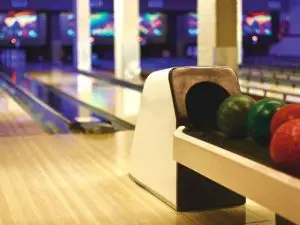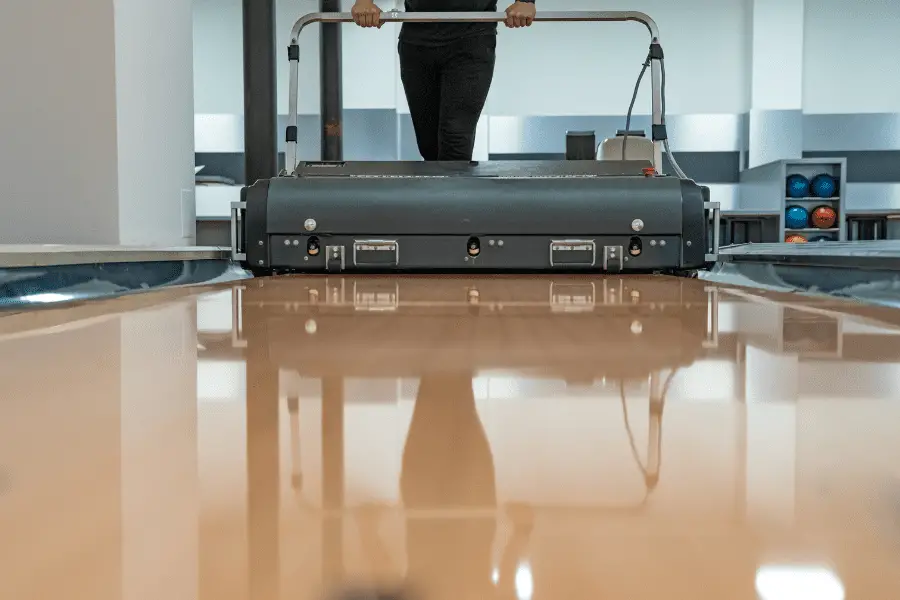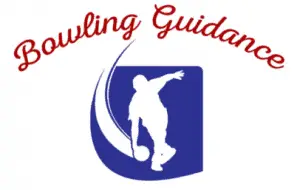
Have you ever wondered what is that shiny residue you have on your bowling ball? Well, it’s the oil your ball has picked up from the lane. If you’re reading this, it means you’re very much interested to know why your ball has oil on it and most importantly, where does it come from. If you take a good look at your bowling alley’s lanes, you’ll see they are always shiny, more or less. So, are all bowling oil patterns the same? Of course, not. Once you look at the lane carefully, you can see that some are glowing and have well-polished sparkles on them, some have worn out oil, and some have no oil on them. So makes them different from each other and how do they impact your bowling performance? Let’s find out.
What is Bowling Oil Patterns?
Before you know the differences of various bowling oil patterns, it is paramount that you know what is an oil pattern with clarity. So the bowling center you go bowling at with your friends and family, have you ever seen a “lane machine”? That is basically a special machine that is used to put oil on the lanes. The machine is programmed to distribute oil in a specific pattern and how much oil to put down and where to do that.
Now here’s an interesting thing- the oil you see isn’t actually spread across the lane evenly. Typically, you will see the machine applies more oil in the middle of the lane than it does on the outside of the lane. It is mainly done this way to help you with perfect hooking, and your ball doesn’t roll toward the outside and goes into the gutter. The oil keeps the ball right on spot and then allows the ball to hit the pins with expected force and knocks them down.

Types of Bowling Oil Patterns
Did you know league bowlers and professional bowlers use different kinds of oil patterns when they bowl? Based on that, bowling oil patterns are mainly divided into two categories. The first one is called the “House Pattern”, greatly used by recreational or league bowlers. House patterns are designed for a bigger margin of error. These patterns are also comparatively easier to control and play on.
The other type of bowling lane is called the “Sport Pattern”, mainly used by professional or highly skilled bowlers. The patterns are designed for no room for error. If you’re soon-to-be entered into the professional world of bowling, you will face some difficulties adjusting to these bowling oil patterns. Oftentimes, even the most experienced players may have a hard time controlling and figuring out their own specific techniques, approaches, and timings with Sport patterns.
The sports patterns are approved by the PBA (Professional Bowling Association). The PBA accredits 16 different types of oil patterns for the lanes. Among them, 8 of them are Animal Patterns and the remaining 8 are Legend Patterns.
PBA Animal Patterns
PBA Cheetah 33:
The Cheetah oil pattern is 33 feet in length and is one of the shortest patterns. When lane surfaces are noticeably worn out, sometimes Cheetah is used. This pattern maximizes the area of the lane that is really close to the gutter with less wear.
PBA Wolf 33:
The oil pattern distance for Wolf is 33 feet. This pattern plays a little flatter in the front with lower oil volume in the middle compared to the 33 Cheetah pattern. Urethane balls with symmetrical/asymmetrical core react to Wolf 33 the best. Besides urethane, any ball with a low differential and high RG will do fine on Wolf 33 oil pattern.
PBA Viper 36:
The Viper oil pattern is one of the shortest patterns for being 36 feet in length. You have to start further outside and throw your ball as straight as possible. It will allow the pattern to break down in a more forgiving way as the session progresses. Starting too far inside may cause this pattern to play difficult.
PBA Bear 39:
The Bear oil pattern is 39 feet in length. It is much more tamed in the middle than the other previous versions. This pattern allows the ball to pick up sooner. Although it depends on your style of bowling, with the Bear 39 pattern, you need balls that have medium to high RG and medium differential.
PBA Chameleon 39:
This oil pattern is 39 feet in length. Chameleon is one of the most challenging patterns. There is no defined starting point tacked out. Areas of the lane surface may force players to start further inside. Strategy is based on the style of play.
PBA Dragon 45:
The oil pattern distance for this is 45 feet. So expect it to play longer and slicker. You won’t get many free hooks to the outside of the lane, but that mainly occurs if you’re using steeper angles that are away from the pocket. Since this pattern has a lot of buff-out on the fronts, you’ll see the mid lane is drying up relatively quickly.
PBA Scorpion 42:
This 42 feet long pattern is one of the challenging ones out in scorpion lane. The length and shape of the pattern will let you play is similar to a lot of house shots you’re already familiar with. Start in the track area and a strong bowling ball, and you will have less room for error on this pattern.
PBA Shark 45:
The 45 feet Shark pattern is the longest and perhaps the most difficult PBA experience pattern. Bowlers complain that it is very slick and the higher length is oftentimes trouble for them. You need to play straighter angles with slower ball speed. If the ball is thrown too hard your ball would go through the breakpoint and come in light and miss the pocket altogether. Playing from the inside part of the lane is recommended.
PBA Legend Patterns
PBA Johnny Petraglia 36:
One of the shortest Legend patterns (36 feet) of PBA is Johnny Petraglia. If you’ve played on this oil pattern before, you’ll know you can control your bowling ball on this pattern very well. The ball rolls down smoothly and at the same time, it doesn’t skid through the breakpoint too much.
PBA Don Carter 39:
This oil pattern has a length of 39 feet. How this oil pattern breaks down depends on the finish of your bowling ball (matte or shiny). The sanded balls will roll earlier and will become more predictable compared to shinier balls. You will be able to make more frequent adjustments than you do on house shots and will face less margin of error on this particular lane.
PBA Don Johnson 40:
Don Johnson oil pattern is 40 feet in distance, but it plays more like Badger instead of Cheetah. Outside shots are not recommended on this specific pattern. You need to throw pretty strong and straight on this pattern.
PBA Earl Anthony 42:
The 42 feet Earl Anthony will require tighter angles. You will receive the best performance with cleaner balls, like the ones that are weaker but shinier. The Earl Anthony lane pattern makes sure that the hooks are on time. Most bowlers don’t struggle that much with this oil pattern.
PBA Mark Roth 42:
The oil pattern distance of Mark Roth is 42 feet. This oil pattern tends to start off oily and requires a smooth ball speed. The patterns can also increase the accuracy of your target. A strong surface bowling ball on this particular pattern is highly recommended.
PBA CP3 42:
The famous NBA star Chris Paul introduced this special pattern to the PBA. Since then, a group of bowlers fell in love with CP3 42 oil pattern. The balls are easy to control and you’ll have enough flexibility on the lanes. A strong surface bowling ball is highly recommended.
PBA Carmen Salvino 44:
This 44 feet oil pattern strips the oil three times within an hour, not to mention the friction and the surface is a little bit different but great. Bowlers love the combination of friction and then a little bit of carrying down which makes the ball go left. If you’re playing with a stronger ball, it will go a little to the right.
PBA Dick Weber 45:
One of the longest patterns, Dick Weber is 45 feet in length. You’ll have a tough time adapting to this oil pattern. But once you have the knack for it, bowling should be easier. Playing from the inside part of the lane is recommended.
What oil pattern do most bowling alleys use?
The most commonly used oil pattern in bowling centers is the ‘House Pattern”. Average bowlers who knock down pin by funneling their bowling ball into the pocket- this pattern is just for them. Typically, you will see, a higher volume of oil is applied to the center of the bowling lane and less towards the outside that is close to the gutters. As on average, most bowlers love to throw their ball in the middle, this house pattern allows them to have less friction between the ball and lane surfaces and makes the travel faster while keeping the power intact. House patterns also allow the ball to hook better. Most of the bowling alleys have 40 feet long house pattern, which is not too short or too long, and ultimately, is the most perfect.
How to read bowling oil patterns?
So what do you think lane patterns mean to bowlers? To know that, as a player, first you have to look at some of the things and pay attention to the lane patterns and what you’re going to do when you see the information about the lane you’re about to use for bowling. There are a few main things you should be looking at.
Video: How To Read Oil Patterns
1. Oil Pattern Distance:
The first one is the “oil pattern distance” because one good general rule of thumb is taking the pattern distance and subtracting by 31. This gives you the idea about what board down the lane you want your ball to be at as it exiting the oil pattern. Now there are some factors that are gonna determine whether the best part of the lane, whether it was a bit to the right or to the left, and will give you more margin of error. Bear in mind, this is merely an assumption of the approximation to use during starting for the best location on the lane.
2. Volume Oil Total:
The amount of oil applied to each lane. Generally, for tournament games, 10-30 ml of oil is applied. The higher the oil volume, the more you want your bowling ball to be aggressive. In house patterns, the volume of oil is usually 25.32 ml.
3. Pattern ratio
Most house patterns have ratios of 8 to 1 or more. This means the oil is concentrated more on the center than on the outside. But we know that already. However, the lower the pattern ratio, the less helpful it will be. This is because the oil will be applied pretty evenly across the lanes.
As per USBC, the sport patterns can be very challenging. It can be as low as 4 to 1, and in some cases way down to 1 to 1- meaning, the lane will be completely flat. The flatter the lane, the more difficult it is to bowl without getting the ball go into the gutter. Your high skills and experiences can help you in this case.
4. Shape of the pattern
If you’re confused about the shape of the pattern, look at the darker color on the Overhead Chart. The darker color represents the concentration of oil in that specific area of the lane. If you look at the House patterns’ overhead chart, you will see, the darker color is more on the center of the lane for the heavy concentration of oil.
5. Conditioner used
Oftentimes the pattern sheet doesn’t mention the conditioner that will be/are used on the pattern. Most of the higher-level or national tournaments actually mention it. But in most cases, the tournament centers just go for the usual house pattern conditioner.
6. Forward Oil Total and Reverse Oil Total
The forward oil of the lane defines the “shape” of the pattern, whereas the reverse oil indicates “hold area.” The oiling machine in the bowling centers buffs the oil beyond the forward-oiled area which is called the “end zone”. The buffed area is mainly smoother, and the transition zone is blended for more room for error.
Vox Video: Hidden Oil Patterns on Bowling Alley
Conclusion
That’s pretty much all you need to know about bowling oil patterns if you weren’t aware of them before. Understanding the surface of a bowling ball is much easier when you have an idea about the lanes you’re about to play on. So don’t bind your knowledge with the lane conditions (dry, medium, and heavy) only. It is important to know about the oil patterns too. So we hope this article was helpful enough to understand then with enough clarity.

